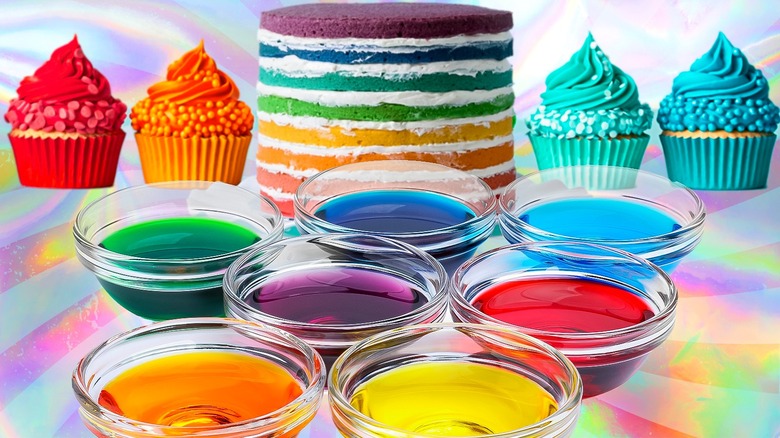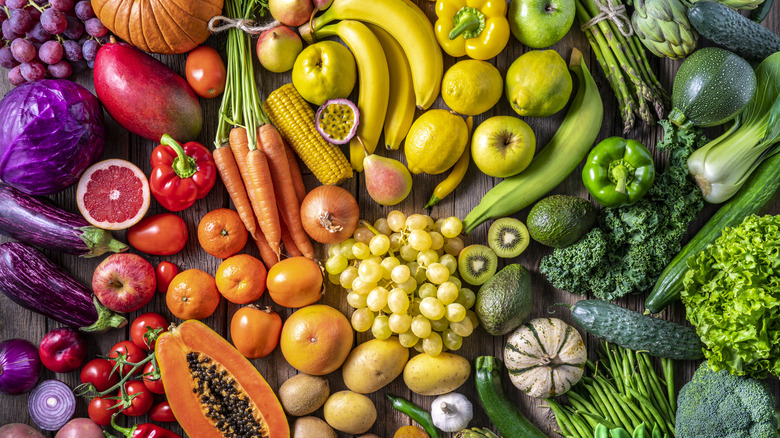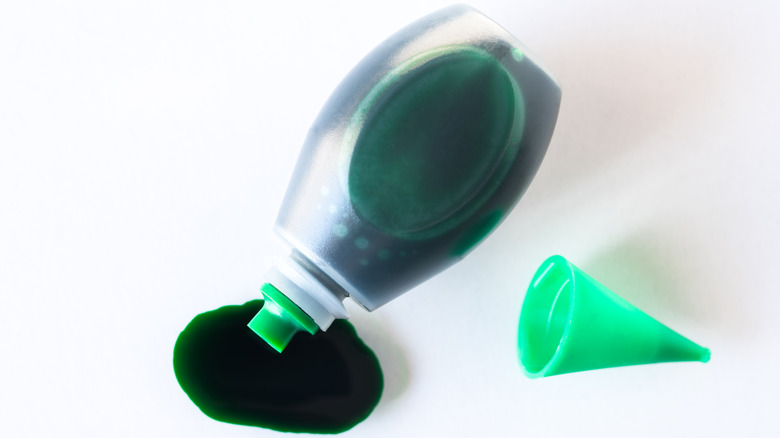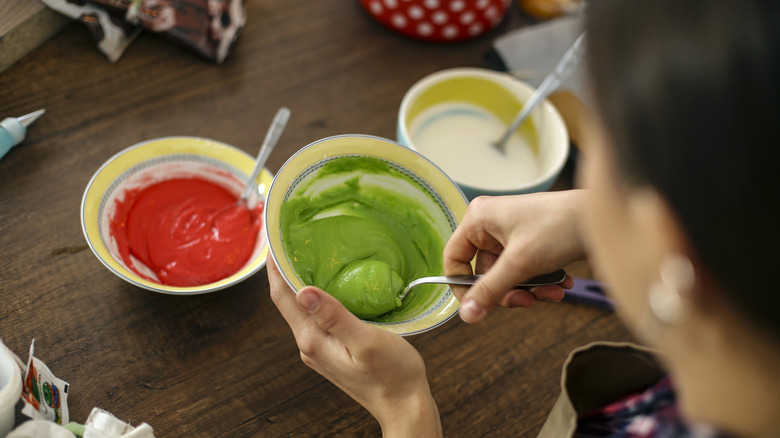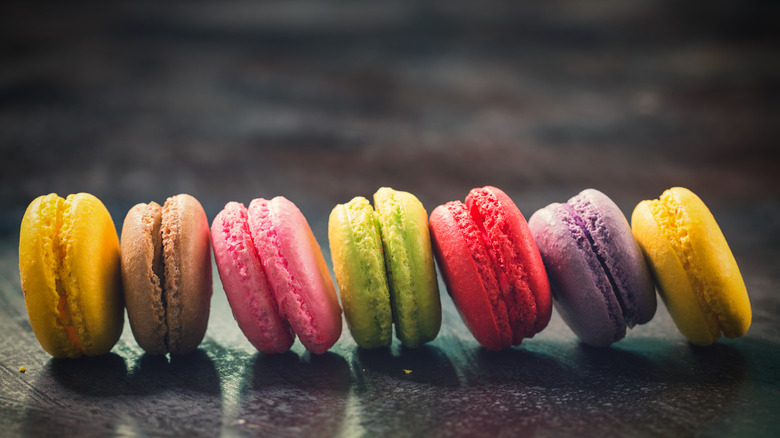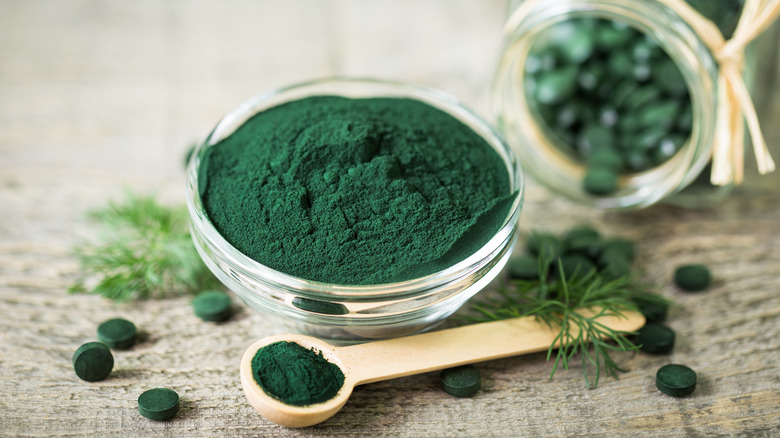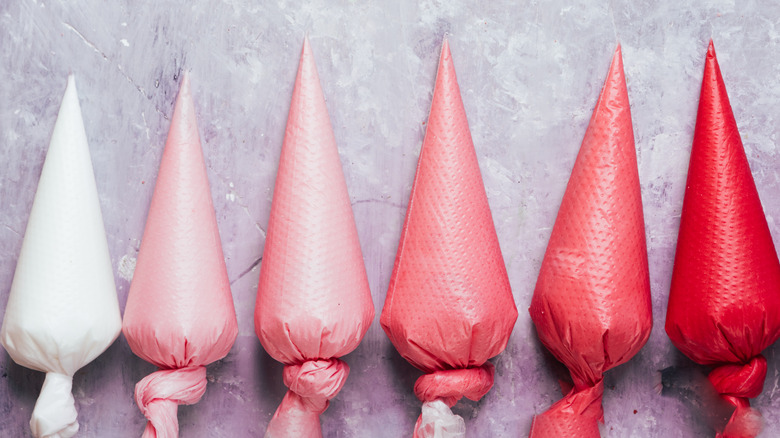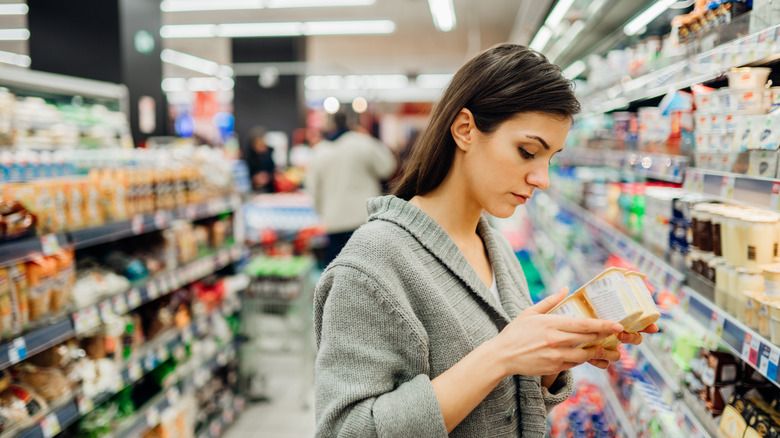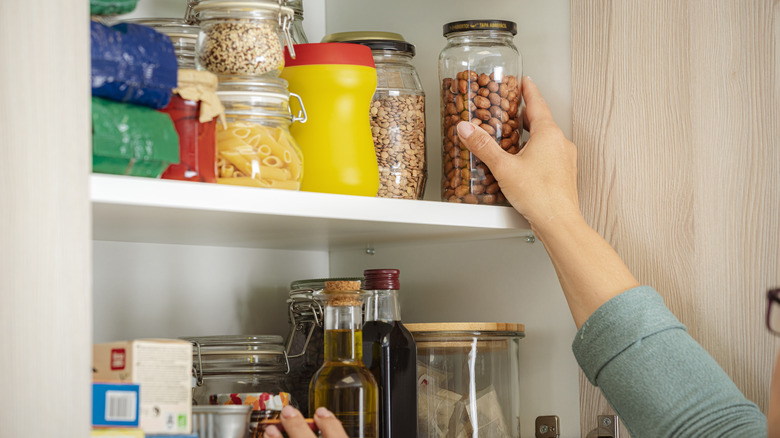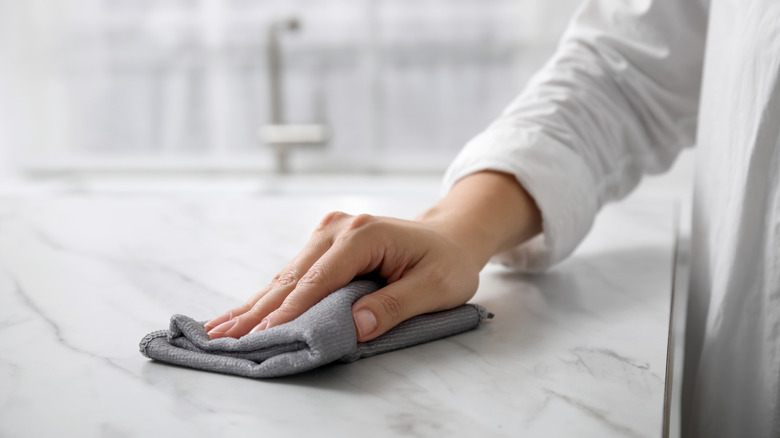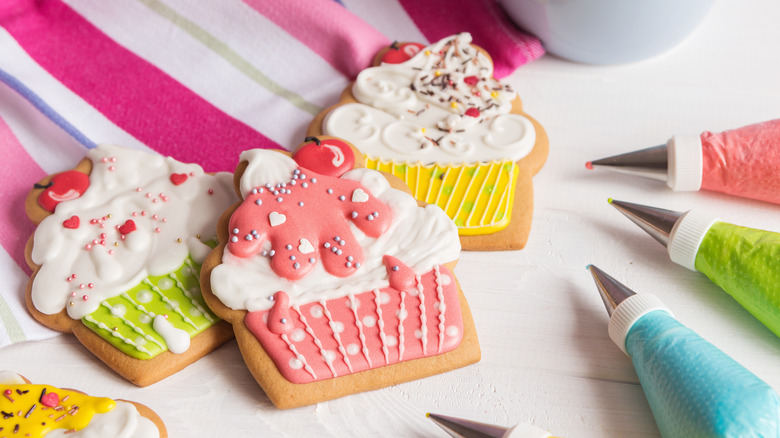What Is Liquid Gel Food Coloring And When To Use It
We may receive a commission on purchases made from links.
While some foods have a bright, enticing color that comes naturally — we're looking at you, perfectly ripe mango — others need a boost to get that hue that makes you want to dig in. That's where food coloring comes in. And if you're adding vibrant colors to your favorite baked goods, liquid gel food coloring is the one you want to reach for. Gel food colorings have a concentrated color power that won't mess with the texture of your Italian meringue or the genoise batter you've worked so hard to perfect, and a small drop will take your bakes from blah to brilliant in a snap.
But why bother with adding color in the first place? Psychologists note that we eat with our eyes before we even taste our food, and a little color can go a long way in making food seem even more delicious — meaning some extra pink could make your strawberry cake taste even more like strawberries. Plus, if you've ever snapped a pic of a perfectly plated entrée before your first bite, you know that the appearance of your meal can be just as impactful as the taste itself. Gel food colorings are an incredibly useful tool to add showstopping design elements to the foods you make, capturing eaters' attention and taste buds.
That means it's time to upgrade your pantry. Put away those leaky bottles of watered-down colors and reach for saturated liquid gel food coloring to take your colorful cooking to new heights.
The history of food coloring
Food coloring isn't just for baking. Colorants — both natural and synthetic — are added to many of our favorite foods to make them more enticing, whether it's enhancing a food's natural color (like making cheese crackers more orange) or adding bright colors to gummy candies to reflect the flavor inside. If you've ever added a little extra turmeric to a curry to brighten the yellow of the sauce or enjoyed the vibrant red-orange of chicken paprikash, you've used natural ingredients to color your food to enhance both the flavor and the appearance.
According to the FDA, the first synthetic organic dye was discovered in 1856, and synthetic colors for foods, drugs, and cosmetics evolved from there. Today, synthetic colorants in the United States are regulated by the FDA to ensure they're safe to consume, so while Blue 1 Lake doesn't sound particularly appetizing, scientists have deemed the additives in foods — as well as the colors used to create liquid gel food coloring — safe to eat.
How is liquid gel food coloring made?
Liquid gel food coloring is an ingredient, most often used in baking, that combines a base of water and sugar or glycerin with combinations of synthetic or natural colors to create a gel that can be added to adjust or change the product of the food you are making. It is pourable but highly concentrated, so a little goes a long way and can help you achieve more saturated colors than with liquid food coloring.
Most liquid gel food colorings are made using synthetic colors. The FDA approves seven color additives for use in human food, and combinations of these additives make up the true rainbow of liquid food gel colors available. In addition to the seven base — or straight — colors, color additives can also be classified as lakes (a chemical reaction of straight colors with precipitants and substrata) and mixtures (color additives mixed with another color additive or non-colored diluent).
Foods can also be colored using natural food coloring. NATCOL is an association of businesses that promote the use of natural food colors — derived from everything from grapes and elderberries to spinach and turmeric. Chefmaster in particular has created a line of natural liquid gel food coloring using naturally derived colorants, enabling both professional and home cooks to add vibrance to their foods without synthetic additives.
Liquid gel food coloring vs. liquid food coloring
The two most common types of food coloring are liquid food coloring and liquid gel food coloring. While they ultimately achieve the same effect, there's a time and a place for each option.
Liquid food coloring is what you're most likely to find in the baking section of the grocery store. It is water-based, so the color isn't quite as concentrated. It's a great choice if your end goal is a pastel hue, but not great if you want to create a brightly-colored treat, as you'll have to add so much liquid food coloring that it could impact the texture of the food you're making. One thing it is great for, though, is dyeing eggs. Combine liquid food coloring with vinegar and water for a range of colors that are safe to eat even if it seeps through a cracked eggshell.
Liquid gel food coloring is a pro baker's most popular choice and is something you should definitely add to your arsenal if you do a lot of baking at home. It's great for frostings, fondant, and icings, and just a dab of color with a toothpick can deliver super-bright results. Because liquid gel food coloring has less moisture than liquid colors, you can add a lot and not worry about ruining your buttercream or cake batter. If you want your Valentine's cookies to be frosted in bright red or your rainbow cake to really wow, use liquid gel food coloring.
Liquid gel food coloring vs. powdered food coloring
Liquid gel food coloring is almost always the best choice for coloring baked goods and candies. However, it is still water-based. If you're working on a really delicate baking project that would suffer from any added moisture (we're looking at you, macarons), turn to powdered food coloring, instead.
Powdered food coloring is dry, highly concentrated, and is designed for use in high-fat foods like chocolate or buttercream, as liquid and gel colors are water-based and won't mix in properly. In the case of chocolate in particular, the extra moisture from even a concentrated gel food coloring could cause the chocolate to seize, so dry powder food coloring is the way to go. If you're the artsy type and want to paint designs on your royal icing or fondant, combine powdered food coloring with vodka to create a paint. The vodka will dry faster than water so you can apply your design without worrying about wet fondant or icing.
Powdered food coloring can be harder to come by unless you're planning to shop online or have a specialty baking store in your area, but for those high-stakes recipes, it's worth seeking out. A little goes a long way, and if you've got powdered food coloring on hand, you don't have to worry about also purchasing liquid or gel alternatives. Plus, you can also get natural powdered food color if you want to avoid synthetic additives.
How does liquid gel food coloring taste?
Though liquid gel food coloring has a base made of water, sugar, and glycerine, it's designed to be tasteless — especially when used in sweets and baked goods. Of course, if you taste plain food coloring you may notice a sweet note and an artificial taste from the colors themselves, but because you need so little gel food coloring to change the color of a food, the other ingredients you use will completely mask any mild flavor from the coloring itself. The one exception is red food coloring, which can have an artificial taste when used because so much is needed to achieve a true red color. To counter this problem, food coloring brands have developed taste-free red food coloring so you can get a bright color without the chemical taste.
The colors in natural liquid gel food coloring come from food products, such as beta-carotene, spirulina, and grapes. They're designed to be flavorless just like synthetic food colorings, though tasting the colors plain may have more flavor than an artificial food color. The good news, though, is that they won't impart major flavor to your baked goods — unlike using products like powdered freeze-dried fruit or matcha powder, which would add both color and taste to the end result.
How to use liquid gel food coloring
Begin by choosing the right set of liquid gel colors. Some producers offer a spectrum of gel colors so you can find exactly what you're looking for. Use a toothpick or a bottle with a dropper to add a small amount of food coloring at a time. When coloring frosting or icing, continue to add color until the desired result is achieved, mixing thoroughly but gently between each addition. If coloring cake batter, Wilton notes that colors tend to bake lighter than they appear in the mixing bowl, so your batter should be colored a shade darker than desired.
When coloring fondant, knead the fondant to soften it before adding color. Knead thoroughly to incorporate the color, and consider wearing gloves so you don't stain your hands. Incorporating color into cake or cookie batter completely can require a lot of mixing. To avoid over-mixing — which can result in tough cakes — add the food coloring to your liquid ingredients before combining them with dry ingredients.
Red is one of the hardest colors to achieve with food coloring, as too little food coloring can result in pink baked goods, but too much can give your food an artificial taste. Wilton makes a no-taste red dye to avoid the flavor issue, and the company recommends making buttercream with solid vegetable shortening instead of only butter, which can give the red frosting a yellow cast, as well as adding a little extra clear vanilla extract.
Where to buy liquid gel food coloring
Liquid food coloring is easy to find in the baking aisle of grocery and big box stores, but liquid gel food coloring can be a little harder to get your hands on. However, as home bakers get more creative and daring with their bakes, niche ingredients are no longer limited to specialty shops and online retailers.
If you can't find liquid gel food coloring in your grocery store, head to the craft store instead. Shops like Michael's — and even Walmart — often feature baking and candy-making aisles, with a plethora of gel food colorings alongside shaped cake molds and seasonal sprinkles. Or head to the mall to visit Sur La Table or Williams-Sonoma, where you'll likely find liquid gel food coloring in the baking section. If you have a specialty baking store in your area, they will have a large selection of food coloring options, including colors specifically for making candy and chocolates. And of course, there's a wide variety of liquid gel food colorings available online. Popular brands include Wilton's, Satin Ice, AmeriColor, Cake Craft, and Chefmaster.
Purchase AmeriColor Soft Gel Paste Student Kit on Amazon for $32.25.
Purchase Satin Ice Food Color Gel, 10ct at Michael's for $24.99
Purchase 8-color Kit Natural Liqua-Gel Liquid Food Coloring from Chefmaster for $32.00.
Nutritional information of liquid gel food coloring
There are liquid gel food coloring options to suit every dietary restriction, meaning any baker can enjoy vibrantly colored desserts. While the ingredients vary from brand to brand, most use a base of water, sugars, and glucose combined with dyes.
AmeriColor's food dyes are gluten- and peanut-free, certified Kosher, and do not contain any animal products — though it does use egg whites in their meringue powder, which may be processed in the same facility. SatinIce liquid gel food coloring is gluten-free, nut-free, dairy-free, vegetarian, and Kosher. Liquid gel food colorings that use artificial colors are more consistent, and it can be easier to achieve the same color each time you use them.
Chefmaster's natural liquid gel food coloring uses natural colors instead of synthetic additives. While the specific natural ingredient used will vary from color to color, the entire line is Kosher and Halal certified, vegan-friendly, and gluten-free. Natural liquid gel food colorings have the benefit of being free of artificial ingredients, but it can be tricky to achieve the same color if some of the coloring has settled between uses so you'll want to shake the jars thoroughly before using.
How to store liquid gel food coloring
All liquid gel food coloring should be stored in a cool, dry place and out of direct sunlight. Be sure to shake the gels before using them to ensure the colors are thoroughly incorporated into the gel for the most consistent results.
Natural colorings are more sensitive than artificial ones and need a little extra care to maintain their potency. According to Chefmaster, its natural food colorings are sensitive to light and heat. It recommends using natural food colorings in applications that have low or no exposure to heat and won't have prolonged exposure to harsh light — not ideal for holiday displays or bakery windows, but great for cookie boxes. Natural liquid gel food coloring should be stored in a cool, dark place away from any sunlight so the colors don't fade before use.
Liquid gel food coloring is more expensive than liquid food coloring, and that price can feel like a lot if your gel colors dry out between uses. Thankfully, Wilton has a solution. The base of liquid gel food colorings is water and glycerin, and Wilton sells uncolored vegetable glycerin that you can use to rehydrate your gel colors or dilute them for a less saturated (but not watery) result.
How to clean up liquid gel food coloring
Food coloring in your cake batter or frosting is good. On your spatulas and your skin? Not so much. While liquid gel food coloring is more concentrated than its liquid counterpart, it is still technically water-based — which means it should come off with a few rounds of handwashing in warm water with soap. If you've got a stubborn spot you can't get off your skin, use a paper towel and some white vinegar to wipe off the stain. Still dyed an unnatural hue? Alternate the vinegar with gently scrubbing using a paste of baking soda and water.
If you get food coloring on fabric like an apron or kitchen towel, soak overnight in water and laundry detergent to loosen the stain. Then, rinse and wash according to the fabric's laundering instructions. Your best chance at keeping beloved clothing clean, though, is to cover it with an apron during baking projects.
For food coloring stains on your countertop, turn back to baking soda. First, wipe up any coloring that hasn't dried as quickly as possible. Make a baking soda and water paste, spread it on the stain, and leave it for 10-15 minutes. Wipe up the paste and clean the counter with warm water to remove any residue.
Recipes using liquid gel food coloring
Using liquid gel food coloring is a fun way to add some pizzaz to your cooking. Use it to color homemade fondant or add it to a spray bottle with water or vodka (which dries super quickly) to top solid-colored frosting with a playful spritz of color. You can even combine liquid gel food coloring with royal icing to make homemade sprinkles in whatever color combination you'd like.
Of course, the most common uses for liquid gel food coloring are coloring frostings, cookies, and cakes. Divide your cake batter and use different colors for each layer to create a cake that reveals a colorful surprise when you slice it, or add liquid gel food coloring for vibrant layers in Italian rainbow cookies.
If you're making multiple colors of buttercream, coloring the frosting in the right order will cut down on cleanup when you're done. To get colors to really shine, consider tempering your buttercream in the microwave during the coloring process. Take a small amount of buttercream, add your gel color, stir to combine, and warm it in the microwave until the color has deepened — this is especially helpful for dark colors like black. Then, stir the colored buttercream into the rest of your batch for a more vibrant hue.
